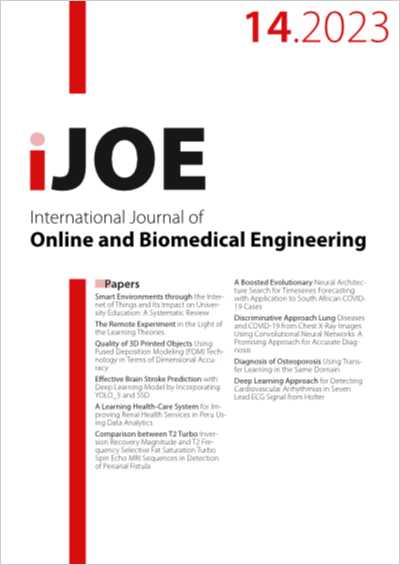Deep Learning Approach for Detecting Cardiovascular Arrhythmias in Seven Lead ECG Signal from Holter
DOI:
https://doi.org/10.3991/ijoe.v19i14.43059Keywords:
— Bigeminy; Trigeminy, ECG signal, deep learning, Convolution neural networkAbstract
Cardiac arrhythmias are abnormalities caused by irregularities in the heart’s electrical conduction system. Cardiovascular diseases (CVD) have been identified as the leading cause of death worldwide. Premature ventricular contraction (PVC) is one of these diseases. It is an arrhythmia that can be linked to a several heart diseases that affect between 40% and 75% of the population. Ventricular bigeminy occurs when one or two premature beats are detected on an electrocardiogram when there is ventricular contraction between two normal heartbeats or trigeminy. The appearance of ventricular bigeminy or trigeminy rhythms is related to angina. Myocardial infarction, hypertension, and congestive heart failure are also possible conditions. Based on deep learning, this paper proposes creating a robust approach for automatically detecting and classifying cardiovascular arrhythmias in long-term electrocardiogram (ECG) recordings from halters based on deep learning (DL). We present a convolutional neural network (CNN) and long-short-time memory (LSTM) model that identifies cardiovascular arrhythmias. We have designed and implemented the proposed model using Python. The model was trained and validated on a database that includes a total of 17 long-recorded ECG signals (24 h) from 17 subjects, which were obtained from Yfa Hospital. The signals were recorded with seven leads holter. The CNN classifier achieved an accuracy of 91.14% as a final result, validated through a 10-fold cross-validation. Moreover, the proposed model was found to be capable of analyzing ECG recordings to classify multiple cardiovascular arrhythmias in the ECG record signals efficiently.
Downloads
Published
How to Cite
Issue
Section
License
Copyright (c) 2023 Omar Hashim Yahya, Vladimir V. Alekseev, Denis Vyacheslavovich Lakomov , Olga Vladimirovna Fomina , Irina Sergeevna Iskevich , Elena Alexandrovna Frolova , Elena Yurievna Kutimova

This work is licensed under a Creative Commons Attribution 4.0 International License.



